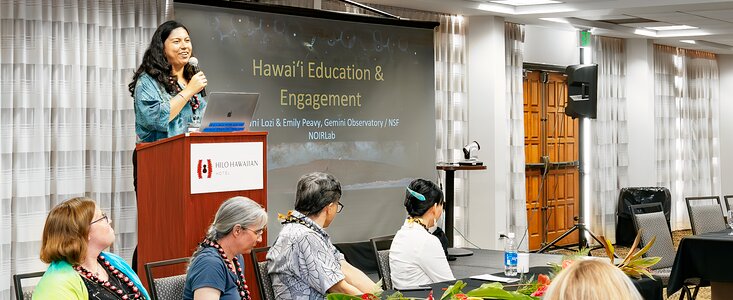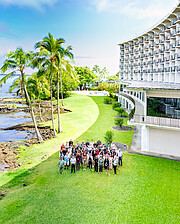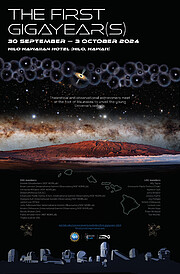NSF NOIRLab Convenes Panel About Community-based Astronomy on Maunakea
First Gigayear(s) Conference in Hilo, Hawai‘i continues conversations about balancing the needs of community and astronomers at the Maunakea Observatories
17 October 2024
Between 30 September and 3 October NSF NOIRLab hosted the First Gigayear(s) Conference at the Hilo Hawaiian Hotel. This conference brought together experts in a variety of fields to discuss the Universe’s first few billion years of evolution, and the galaxies, black holes, stars, chemicals, and large-scale structure that formed during that time.
A considerable portion of the conference was also focused on discussions of the historical, geographical, and cultural context surrounding astronomical activities on Maunakea and the interface between the Maunakea Observatories and the local community at large. These discussions were paired with activities throughout the conference that focused on the culture, beauty, and diversity of Hawai‘i.
Adding to the ongoing community conversation about these topics, NOIRLab hosted two discussion panels featuring observatory directors and project managers, the director of ‘Imiloa Astronomy Center (‘Imiloa) — the world’s only native astronomy center — and experts in community building and outreach. This was the first time that such a discussion had formally taken place within the program of an astronomical conference in Hawai‘i. The panels were also open to members of the public.
The first panel was titled Historical Context, Current Climate, and Future Outlook for Astronomy on Maunakea, and featured: Jean-Gabriel Cuby (Director, Canada France Hawai‘i Telescope, CFHT), who gave a broad overview of the findings of a study on the relationship of astronomy, land, and community on Maunakea; Ka‘iu Kimura (Director, ‘Imiloa), who introduced ‘Imiloa’s mission of connecting science and culture, as well as the history of these connections through the various controversies associated with Maunakea; Doug Simons (Director, Institute of Astronomy at University of Hawai‘i), who gave an overview of the University of Hawai‘i role in stewardship and engagement; and Rich Matsuda (Director, Keck Observatory), who discussed the formation and role of the Maunakea Stewardship and Oversight Authority.
The second panel was titled Community Engagement and Providing Local Pathways to STEAM Careers in Astronomy, and featured: Fengchuan Liu (Project Manager, Thirty Meter Telescope (TMT) International Observatory) and Yuko Kakazu (Education, Outreach, and Broader Impacts Manager & Scientist, TMT), who presented TMT’s current engagement model and how and why it was created; Mary Beth Laychak (Director of Strategic Communications, CFHT) and Nadine Manset (Astronomer & Maunakea Astronomy Outreach Committee Chair, CFHT), who discussed Maunakea Observatories' community engagement efforts and community relations; and Leinani Lozi (Hawaiʻi Education & Engagement Manager, International Gemini Observatory/NOIRLab) and Emily Peavy (Senior Education & Engagement Assistant, Gemini/NOIRLab), who discussed Gemini/NOIRLab’s current engagement model in Hawai‘i.
These panels painted a large picture of the context in which astronomical activities take place on Maunakea, the relationship of the Maunakea Observatories and their staff to the local community, and a broad look towards the future. They also encouraged participants to consider the greater context of where their scientific activities take place, whether it be on the islands or elsewhere in the world. Institutions from a total of 12 countries and hundreds of partners were represented among the in-person and online participants of the conference.
Recordings of both panels are available here.
More information
NSF NOIRLab (U.S. National Science Foundation National Optical-Infrared Astronomy Research Laboratory), the U.S. center for ground-based optical-infrared astronomy, operates the International Gemini Observatory (a facility of NSF, NRC–Canada, ANID–Chile, MCTIC–Brazil, MINCyT–Argentina, and KASI–Republic of Korea), Kitt Peak National Observatory (KPNO), Cerro Tololo Inter-American Observatory (CTIO), the Community Science and Data Center (CSDC), and Vera C. Rubin Observatory (operated in cooperation with the Department of Energy’s SLAC National Accelerator Laboratory). It is managed by the Association of Universities for Research in Astronomy (AURA) under a cooperative agreement with NSF and is headquartered in Tucson, Arizona. The astronomical community is honored to have the opportunity to conduct astronomical research on I’oligam Du’ag (Kitt Peak) in Arizona, on Maunakea in Hawai‘i, and on Cerro Tololo and Cerro Pachón in Chile. We recognize and acknowledge the very significant cultural role and reverence that these sites have to the Tohono O’odham Nation, to the Native Hawaiian community, and to the local communities in Chile, respectively.
Links
Contacts
Brian Lemaux
International Gemini Observatory/NSF NOIRLab
Email: brian.lemaux@noirlab.edu
Emanuele Paolo Farina
International Gemini Observatory/NSF NOIRLab
Email: emanuele.farina@noirlab.edu
Josie Fenske
Jr. Public Information Officer
NSF NOIRLab
Email: josie.fenske@noirlab.edu





